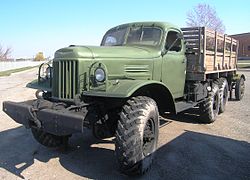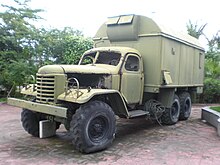ZIL-157
| ZIL | |
|---|---|
|
ZIL-157 with a flatbed in a technical museum
|
|
| ZIL-157 | |
| Manufacturer: | Zavod imeni Likhacheva |
| Production period: | 1958-1994 |
| Previous model: | ZIS-151 |
| Successor: | ZIL-131 |
| Technical specifications | |
| Designs: | Tipper , flatbed , military vehicle |
| Engines: | 6-cylinder gasoline engine |
| Power: | 76-81 kW |
| Payload: | up to 4.5 t |
| Perm. Total weight: | about 10 t |
The ZIL-157 ( Russian ЗИЛ-157 ), also transcribed as SIL-157 in German-speaking countries , is a three-axle medium-weight truck that was first built by Sawod imeni Lichatschowa from 1958 to 1994 in the Soviet Union or Russia . It is the successor to the ZIS-151 , but in terms of design it emerged from the ZIL-164 . The vehicle was the standard model of the Soviet Army until it was replaced there in 1979 by the ZIL-131 and the heavier Ural-375D .
Vehicle history


The revision of the ZIS-151 began shortly after the start of series production . The new project was named ZIS-157. By 1956, two prototypes had been produced which had some technical innovations compared to the ZIS-151. This also included tires specially developed for this vehicle, which were particularly wear-resistant thanks to the use of several layers of material. The spare wheel was no longer mounted behind the driver's cab, but under the truck, which made it possible to shorten the frame and thus the entire truck. A tire pressure control system was also installed, which significantly improved off-road mobility.
Series production began on September 18, 1958 in Moscow. In the course of de-Stalinization , however, now under the name ZIL-157, since the plant was renamed in 1956 from "Sawod imeni Stalina" to "Sawod imeni Lichatschowa". In the same year, the truck won an award at the world exhibition in Brussels .
In 1961 a new version was introduced. The ZIL-157K had a more powerful engine, which it took over from the ZIL-131 as well as the rest of the drive train. This model was built until production in Moscow was discontinued in 1978. From then on, the Uralsky Avtomotorny Zavod (UAmZ) took over the production of the truck. Here it was revised again and designated ZIL-157KD. The payload increased by 500 kg to five tons, and three tons of cargo could still be transported in the area. Production officially ran until 1992, with vehicles still being assembled from existing parts until 1994. A total of 797,934 ZIL-157 trucks were built by both manufacturers in 36 years.
The ZIL-157 was also used in the GDR , especially militarily by the NVA . From 1960, tractors and vehicles with special bodies (also for the civil sector) were imported in large numbers.
In the Soviet Union, the vehicle received several nicknames from the population, including "crocodile" because of the long bonnet and the characteristic radiator grille.
Model variants
The following list does not claim to be complete.
- ZIL-157 - basic version, built from 1958 to 1961. The built-in six-cylinder engine developed 104 hp (76 kW).
- ZIL-157W - tractor unit, built from 1958 to 1962. The vehicle was equipped with a second fuel tank with a capacity of 150 l.
- ZIL-157G - In this special version, all electrical devices were shielded.
- ZIL-157E - chassis for special bodies
- ZIL-157EG - chassis for special structures with shielded electrical equipment
- ZIL-157L - model with built-in power steering
- ZIL-157Ju - export version for tropical areas. The main difference was that no heater was built into the vehicle.
- ZIL-157K - Modernized version, built from 1961 to 1978. The engine output was increased to 109 HP (80 kW) and some components were replaced. From this point on, the brake system, clutch and transmission were identical to those of the ZIL-131 .
- ZIL-157KW - tractor unit based on the modernized ZIL-157K. Built from 1962 to 1978.
- ZIL-157KG - modernized version with shielded electrical equipment
- ZIL-157KE - (Russian ЗИЛ-157КЕ) modernized chassis
- ZIL-157KE - (Russian ЗИЛ-157КЭ) export version of the ZIL-157K
- ZIL-157KJu - Export version especially for tropical areas
- ZIL-157KD - Again modernized version with engine of the ZIL-130 . The vehicle was designed by UAmZ and built there from 1978 to 1992/94.
- ZIL-157KDW - tractor unit based on the ZIL-157KD
- ZIL-157KDE - chassis based on the ZIL-157KD
- ZIL-165 - prototype with cabin of the ZIL-130, not built in series.
- ZIL-MMZ-4510 - Tipper based on the ZIL-157, which was built from 1989.
Furthermore, between 1958 and 1986 at Sewdormasch in Severodvinsk heavy snow throwers of the type D-470 were built on chassis of the ZIL-157 (or later ZIL-157K). The engine of the vehicle was removed and a six-cylinder diesel engine of the type У2Д6-С2 was installed in the closed structure. With a displacement of 19,440 cm³, it produced 175 hp (129 kW) and powered both the snow blower and the vehicle itself. The latest version of the machines can clear up to 720 tons of snow per hour.
A copy of the ZIL-157, the Jiefang CA-30, was also made in China.
Technical specifications
For the revised version ZIL-157K, status 1971.
- Engine: six-cylinder four-stroke gasoline engine, water-cooled
- Motor type: "ZIL-157K"
- Power 110 hp (81 kW) at 2800 min -1
- Displacement: 5555 cm³
- Bore: 101.6 mm
- Stroke: 114.3 mm
- Compression: 6.5: 1
- Torque: 338 Nm at 1100 to 1400 min -1
- Mixture preparation: carburettor, type K-84M
- Firing order: 1–5–3–6–2–4
- Gearbox: mechanical five-speed gearbox, first gear unsynchronized
- Transfer case with two-stage off-road reduction
- Tank capacity: 150 + 65 l
- Consumption: 42 l / 100 km
- Range: 510 km
- Top speed: 65 km / h
- Braking distance from 30 km / h: 12 m
- Tire size: 12.00-18 "
- On-board voltage: 12 V.
- Starter: ST15-B, 1.3 HP
- Alternator: G108-W, 225 W
- Drive formula : 6 × 6
Dimensions and weights
- Length: 6922 mm
- Width: 2315 mm
- Height: 2360 mm (above cabin), 2915 mm (above structure with tarpaulin)
- Wheelbase: 3665 + 1120 mm
- Front track: 1755 mm
- Rear track: 1750 mm
- Ground clearance: 310 mm
- Turning circle: 22.4 m
- Height of loading sill: 1388 mm
- Dimensions of loading area (inside, L × W × H): 3570 × 2090 × 355 mm
- Empty weight (with winch): 5800 kg
- Payload: 4500 kg (road), 2500 kg (terrain)
- permissible total weight: up to 10,450 kg (fully loaded + two people)
- permissible trailer load with 2500 kg payload: 3600 kg
- Front axle load: 3050 kg
- Rear axle load: 7400 kg (double axle)
literature
- New Soviet trucks. In: Motor Vehicle Technology 4/1958, pp. 138–141.
- Ralf Kunkel: Type compass. GDR trucks. Imports from the USSR. Motorbuch Verlag Stuttgart, 1st edition 2015, ISBN 978-3-613-03799-1 .
- Ministry of Automobile Transport of the RSFSR ; Vehicle Construction Institute NIIAT: Short Automobile Manual (краткий автомобильный справочник). Transport Publishing House, 6th edition, Moscow 1971.
Individual evidence
- ↑ a b c d e f g website with detailed vehicle history, technical data and modifications (Russian)
- ↑ Technical article in the vehicle with mention of the number of units built (Russian)
- ↑ Website for ZIL-157, including historical photographs and various nicknames (Russian)
- ↑ Detailed website for the D-470 snow blower (Russian)
- ↑ Website for the Chinese CA-30 (English)
- ^ Ministry of Automobile Transport of the RSFSR ; Vehicle Construction Institute NIIAT: Short Automobile Manual (краткий автомобильный справочник). P. 234 ff.






